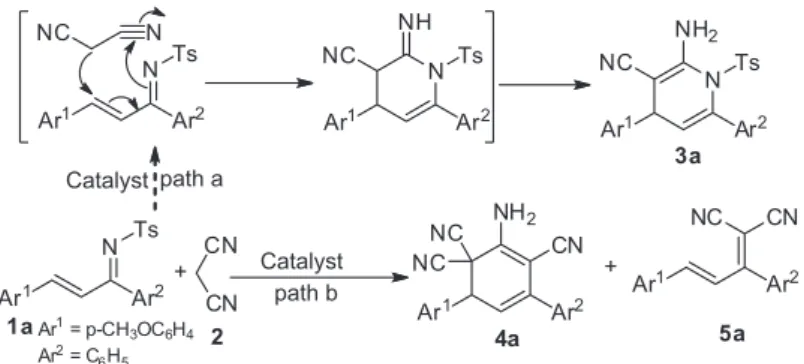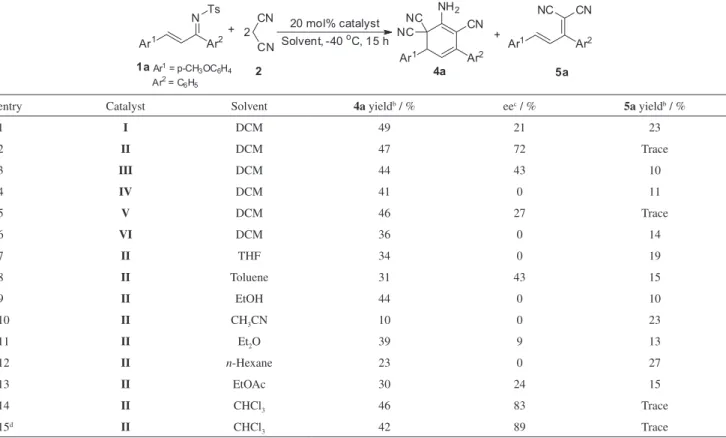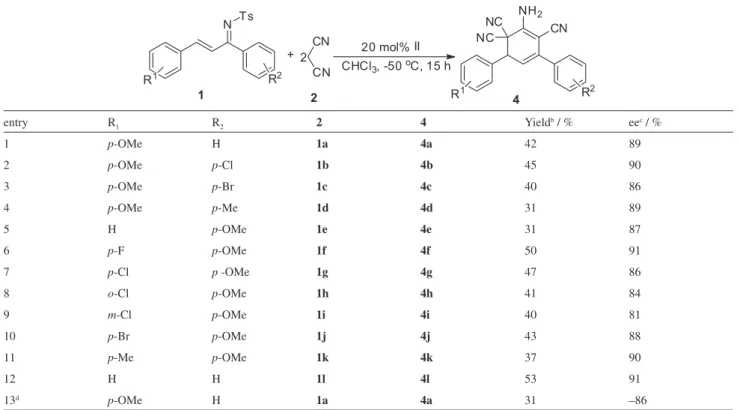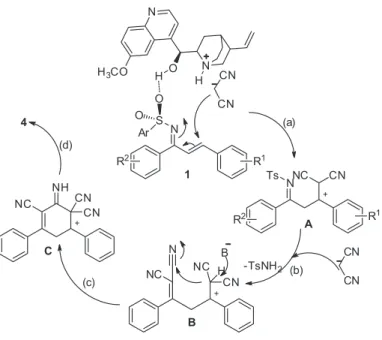Communication
J. Braz. Chem. Soc., Vol. 26, No. 3, 405-410, 2015. Printed in Brazil - ©2015 Sociedade Brasileira de Química 0103 - 5053 $6.00+0.00
*e-mail: xiao_yan_lu@163.com, xiejw@zjnu.cn
Asymmetric Synthesis of Highly Functionalized Cyclohexa-1,3-dienes via
Organocatalyzed One-Pot Three-Component Domino Reaction of Malononitrile
with
α
,
β
-Unsaturated Imines
Wei Chen,a Ren-Zun Zhang,b Xiao-Yan Lu*,c and Jian-Wu Xie*,b
aZhejiang Pharmaceutical College, Ningbo 315100, People’s Republic of China
bKey Laboratory of the Ministry of Education for Advanced Catalysis Materials, Department of Chemistry and Life
Sciences, Zhejiang Normal University, Jinhua 321004, People’s Republic of China
cNingbo No. 2 Hospital, Ningbo 315010, People’s Republic of China
The enantioselective synthesis of highly functionalized cyclohexa-1,3-dienes was achieved via an organocatalytic one-pot three-component domino reaction. In addition, a possible mechanism accounting for the reaction was proposed.
Keywords: organocatalytic, domino reactions, quinidine, cyclohexa-1,3-dienes
Introduction
Regio-, chemo-, and enantioselective construction of six-membered carbocycles is one of the most fundamental and important issues in synthetic organic chemistry because of the importance and prevalence of these motifs in many biologically active natural products and drug molecules.1
Intermolecular annulation reaction is one of the most ideal processes for the rapid and selective construction of complex cyclic structures in a one-pot manner from relatively simple building blocks.2,3 While the annulation
approaches to construct six-membered carbocycles have typically relied on the [4 + 2] and [5 + 1]-modes4,5 and to
the best of our knowledge, there is no report on the direct enantioselective organocatalytic [1 + 3 + 2]-processes for the synthesis of chiral six-membered carbocycles. In addition, multicomponent domino reactions (MDRs), in which more than one bond is being formed in a multistep one-pot reaction sequence are of great importance in organic chemistry because they have several advantages over a series of individual reactions.6-8 First, multicomponent
domino reactions allow construction of complex structures in as few steps as possible. In theory, they also eliminate the need for a purification step (or steps). Since the intermediates are not isolated it becomes easier to work with sensitive or unstable intermediates. Finally, employing multicomponent domino reactions will reduce the
amount of waste formed and save on cost and amounts of reagents, solvents, time. In connection with our continuous interest in organocatalysis, and on the basis of our recent achievement,9 we report herein an alternative approach to
the synthesis of highly functionalized cyclohexa-1,3-dienes by an enantioselective organocatalytic one-pot three-component domino [1 + 3 + 2] pathway using commercially available, low cost quinidine as the organocatalyst.
Results and Discussion
N-Sulfonyl-1-aza-1,3-dienes, which were found by
Boger et al.10 to participate as a 4πcomponent in organic synthesis, have been well demonstrated as versatile electrophiles in cycloaddition reactions such as [4 + 2], [3 + 2], [2 + 2], etc., as well as 1,2- and 1,4-addition reactions.11 Many nucleophiles have been reported in the
addition reactions involving N-sulfonyl-1-aza-1,3-dienes.10
However, to the best of our knowledge, malononitriles have never been reported to date as nucleophiles for the asymmetric addition to N
-sulfonyl-1-aza-1,3-dienes. We envisioned the reaction sequence involving Michael addition of N-sulfonyl-1-aza-1,3-dienes 1 to
malononitrile 2 by using H-bonding activation, followed
observed, butcyclohexa-1,3-diene 4a, which was isolated
in the presence of the organocatalysts I-VI (Figure 1) in
dichloromethane (DCM) at –40 °C (Scheme 1, path b). Notably, 5a was also isolated as a byproduct in low yield.
Subsequently, investigations were carried out in order to find the optimal reaction conditions for the formation of enantiomeric piperidine derivatives 3 and
the N-sulfonyl-1-aza-1,3-diene 1a was chosen as a model
substrate. The reaction was first carried out in the presence of the organocatalysts I-VI in DCM at –40 °C. We first
investigated the catalytic activity of organocatalysts for the multicomponent domino annulation of N
-sulfonyl-1-aza-1,3-diene 1a with malononitrile 2. A few representative
results are shown in Table 1. We tended to activate both donors and acceptors to promote this transformation and the multicomponent domino annulation was first catalyzed by thiourea-tertiary amine I. The reaction proceeded smoothly
and cyclohexa-1,3-diene 4a was obtained in moderate yield,
while the enantiomeric excess (ee) was very low (Table 1, entry 1). Cinchona alkaloids have appeared to be efficient organocatalysts in asymmetric transformations since the basic tertiary nitrogen of cinchona alkaloids could activate nucleophiles by deprotonation, whereas the secondary hydroxyl group would serve as hydrogen-bonding donor in the activation of electrophiles such as α,β-unsaturated
carbonyl compounds or nitroalkenes. As such, quinidine II
and cinchonine III were screened and better results were
obtained (Table 1, entries 2-3).
Especially, quinidine II exhibited excellent catalytic activity and even much higher enanotioselectivity (72% ee) was obtained (Table 1, entry 2). Catalysts IV-VI derived from cinchona alkaloids were also found to be highly active catalysts, product 4a was obtained in moderate yield, while
the ee was very low (Table 1, entries 4-6). In the next stage of the studies, different solvents and temperatures were screened. The reaction proceeded smoothly and afforded moderate yields (10-44%) and varied enantioselectivities (Table 2, entries 7-13) in different solvents. However, chlorinated solvents were the most useful in terms of enantioselectivities and yields (Table 1, entries 2 and 14). Notably, the multicomponent domino annulation worked very well in chloroform (CHCl3) to afford 4a with high
enantioselectivity in 46% yield (Table 1, entry 14) and chloroform turned out to be the solvent of choice and was used for temperature screening. By lowering the reaction temperature to –50 oC, high enantioselectivity (89% ee)
and a moderate yield (42%) were obtained in the presence of quinidine II (Table 1, entry 15). Based on the above screened results, the optimal reaction conditions of 1 eq. 1
and 2.5 eq. 2 in chloroform with 20 mol% quinidine II at
–50 oC were established.
With the optimized conditions in hand, we investigated the scope of the reaction. The results are summarized in Table 2. Various substituted N-sulfonyl-1-aza-1,3-dienes
1a-l were treated with malononitrile 2. The reaction proved
to be general, since moderate yields (31-53%) and high enantioselectivities (81-91% ee) were observed in all cases. The position of the substituent on the aromatic ring had no significant influence on the stereochemical outcome of the reaction. Moreover, the multicomponent domino annulation with N-sulfonyl-1-aza-1,3-dienes bearing either
electron-withdrawing or electron-donating substituents proceeded without noticeable changes in yield or stereoselectivity.
N-sulfonyl-1-aza-1,3-dienes with electron withdrawing
+ CN
CN
Ar1 Ar2
N Ts
2
Catalyst
Ar1 Ar2
NC NH2 CN
NC
4a
Ar1 Ar2
CN
+
NC
5a
Ar1 Ar2
N Ts
NC N
Ar1 Ar2
N Ts
NC NH
Ar1 Ar2
N Ts
NC
NH2
3a
1aAr1= p-CH 3OC6H4
Ar2= C 6H5
path a
path b Catalyst
Scheme 1. Potential strategies for the cyclization of α,β-unsaturated imines with malononitrile.
N N HO
R II R = OCH3 III R = H IV R = OH
N N H N
O OH
H N
N H
N
S F3C
CF3
OCH3
N N H N H
S CF3
F3C
I
VI
V
substituents on the ortho, meta or para positions afford
cyclohexa-1,3-dienes 4 with slightly inferior yields
and enantioselectivities (Table 2, entries 7-9). The opposite configuration of cyclohexa-1,3-diene 4a was
obtained with slightly inferior enantioselectivity when the multicomponent domino annulation was catalyzed by quinine.
This catalytic cascade is a three-component annulation comprising a N-sulfonyl-1-aza-1,3-diene, two
malononitriles and a simple chiral tertiary amine, which is capable of catalyzing each step of this triple cascade. To obtain mechanistic information about the enantioselective multicomponent domino annulation, several control experiments were conducted. The reaction proceeded smoothly between 6l and malononitrile 2 in good yield under
the same reaction conditions, while the enantioselectivity is very low (Scheme 2). Even when p-toluenesulfonamide
(TsNH2) was added as an additive, the enantioselectivity
is very poor (Scheme 2). The sulfonyl group proved to be a key group in the N-sulfonyl-1-aza-1,3-dienes 1 in
the enantioselective multicomponent domino annulation. On the basis of the above observations and previous studies,3 a possible mechanism for the present tertiary
amine-catalyzed three-component cascade annulation was
proposed (Scheme 3). We propose a stepwise mechanism in which the rate-determining step consists of a dual Brønsted base/hydrogen-bonding activation step involving both the
N-sulfonyl-1-aza-1,3-dienes 1 and malononitrile 2. First,
malononitrile 2 was deprotonated by the quinidine nitrogen
atom to generate an ion pair, while the hydroxyl group coordinates to the oxygen atom of the sulfonyl group, bringing the two reactants into close proximity. Next, attack of the nucleophile on the N
-sulfonyl-1-aza-1,3-dienes 1 generates intermediate A followed by Knoevenagel
condensation to produce intermediate B. Then, further
intramolecular cyclization reactions occurred, followed by proton transfer of the resulting adducts as a facile and efficient approach to the target compounds 4 (Scheme 2). In
addition, the molecular structure of enantiopure 4l has been
firmly determined by X-ray (Figure 2). The enantiopure crystals of 4 suitable for determination of the absolute
configuration were not obtained in our lab.
Crystallographic data
Crystal data for 4l: C21H14N4 (322.36); monoclinic;
P2(1)/c; a = 7.995(10)Å, b = 13.031(16) Å, c = 16.63(2) Å;
V = 1733(4) Å3; Z = 12; specimen 0.326 × 0.312 × 0.218 mm3; Table 1. Screening of the reaction conditions of malononitrile 3 with N-sulfonyl-1-aza-1,3-diene 2a catalyzed by 1a
+ CN
CN
20 mol% catalyst
Solvent, -40oC, 15 h
Ar1 Ar2
N Ts
Ar1 Ar2
NC
NH2
CN NC
4a 1aAr1= p-CH
3OC6H4
Ar2= C 6H5
2
Ar1 Ar2
CN
+
NC
5a
2
entry Catalyst Solvent 4a yieldb / % eec / % 5a yieldb / %
1 I DCM 49 21 23
2 II DCM 47 72 Trace
3 III DCM 44 43 10
4 IV DCM 41 0 11
5 V DCM 46 27 Trace
6 VI DCM 36 0 14
7 II THF 34 0 19
8 II Toluene 31 43 15
9 II EtOH 44 0 10
10 II CH3CN 10 0 23
11 II Et2O 39 9 13
12 II n-Hexane 23 0 27
13 II EtOAc 30 24 15
14 II CHCl3 46 83 Trace
15d II CHCl
3 42 89 Trace
aReactions performed with 0.1 mmol of 1a, 0.25 mmol malononitrile, 20 mol% catalyst in different solvents at –40 oC; bisolated yield; cdetermined by
T = 296(2) K; SIEMENS P4 diffractometer; absorption
coefficient 0.076 mm-1; reflections collected 9576;
independent 3046 [R(int) = 0.0272]; refinement by full-matrix least-squares on F2, data/restraints/parameters
3046/0/227; goodness-of-fit on F2 = 1.026; final R indices
[I > 2σ(I)] R1 = 0.0380, wR2 = 0.0905; R indices (all
data) R1 = 0.0602, wR2 = 0.1016; largest diff. peak and hole 0.166 and –0.123 e Å-3. CCDC 1035842 contains
the supplementary crystallographic data for the structure of 4l. These data can be obtained free of charge from
the Cambridge Crystallographic Data Centre via www.
ccdc.cam.ac.uk/data_request/cif or on application to CCDC, 12 Union Road, Cambridge CB2 1EZ, UK [fax: (+44)-1223/336-033; e-mail: deposit@ccdc.cam.ac.uk].
Conclusions
In summary, a concise and stereoselective methodology for the synthesis of highly substituted carbocycles has been developed. Further investigation on the application of the present strategy to construct complex organic molecules is currently underway.
Table 2. Quinidine-catalyzed reaction of N-sulfonyl-1-aza-1,3-dienes 1 with malononitrile 2a
+ CN
CN
20 mol% II
CHCl3, -50oC, 15 h
N Ts NC
NH2 CN NC
4
1 2
R1 R2
R1 R2
2
entry R1 R2 2 4 Yieldb / % eec / %
1 p-OMe H 1a 4a 42 89
2 p-OMe p-Cl 1b 4b 45 90
3 p-OMe p-Br 1c 4c 40 86
4 p-OMe p-Me 1d 4d 31 89
5 H p-OMe 1e 4e 31 87
6 p-F p-OMe 1f 4f 50 91
7 p-Cl p -OMe 1g 4g 47 86
8 o-Cl p-OMe 1h 4h 41 84
9 m-Cl p-OMe 1i 4i 40 81
10 p-Br p-OMe 1j 4j 43 88
11 p-Me p-OMe 1k 4k 37 90
12 H H 1l 4l 53 91
13d p-OMe H 1a 4a 31 –86
aReactions performed with 0.1 mmol of 1a, 0.25 mmol malononitrile, 20 mol% catalyst in different solvents at –50 oC; bisolated yield; cdetermined by
chiral HPLC analysis; dcatalyzed by quinine.
+ CN
CN
20 mol% II CHCl3, -50oC, 15 h
CN NC
NH2
CN NC
4l
89% yield, 19% ee NC
6l 2
+ CN
CN
20 mol% II 100 mol% TsNH2
CHCl3, -50oC, 15 h
CN NC
NH2 CN NC
4l
81% yield, 5% ee NC
6l 2
(1)
(2)
Experimental
Nuclear magnetic resonance (NMR) spectra were recorded with tetramethylsilane as the internal standard. Thin-layer chromatography (TLC) was performed on glass-backed silica plates. Column chromatography was performed using silica gel (200-300 mesh) eluting with ethyl acetate and petroleum ether. 1H NMR spectra were
recorded at 400 MHz, and 13C NMR spectra were recorded at
100 MHz. Chemical shifts were reported in parts per million
(ppm), and the residual solvent peak was used as an internal reference: proton (chloroform d 7.26, DMSO d 2.50), carbon (chloroform d 77.0, DMSO d 39.5). Multiplicity was indicated as follows: s (singlet), d (doublet), t (triplet), q (quartet), m (multiplet), dd (doublet of doublet), bs (broad singlet). Coupling constants were reported in Hertz (Hz).
Optical rotations were measured in CHCl3 solution at
589 nm and 20 oC. Enantiomeric excess was determined by
high-performance liquid chromatography (HPLC) analysis on Chiralcel IC, OD and Chiralpak AD columns. Infrared (IR) spectra were recorded using a Perkin-Elmer 1600 Series FTIR. Electrospray ionization-high resolution mass spectrometry (ESI-HRMS) was measured with a Finnigan LCQDECA ion trap mass spectrometer. Chloroform was
distilled from CaH2. The N-sulfonyl-1-aza-1,3-dienes were
easily prepared according to Carretero and co-workers’ procedure.12
General procedure for the one-pot domino reaction of N-tosyl-1-aza-1,3-dienes and malononitrile
To a solution of N-sulfonyl-1-aza-1,3-dienes 1a
(0.10 mmol) in CHCl3 (0.5 mL) was added catalyst II
(6.5 mg, 20 mol%) at –50 oC under N
2. Then, a solution
of malononitrile 2 (42 µL, 0.25 mmol) in anhydrous
CHCl3 (1.5 mL) was added. Subsequently, CHCl3 (0.5 mL)
was also added. The mixture was kept at the temperature until the reaction was completed. Then the reaction mixture was concentrated and the residue was purified by flash chromatography on silica gel (petroleum ether/ethyl acetate = 5:1) to give 4.
Supplementary Information
Supplementary data are available free of charge at http://jbcs.sbq.org.br as PDF file.
N
N O
H3CO
N S Ar
O
O CN
CN
1
H H
R2 R1
N
Ts NC CN
+
R2 R1
(a)
-TsNH2 (b)
CN CN
NC
CN NC
+
B H N NC
CN CN
+
NH
4
(c) (d)
(a) Michael addition; (b) Knoevenagel condensation; (c) Intramolecular cyclization; (d) Proton transfer
A
B C
Scheme 3. Plausible mechanism.
Figure 2. Molecular structure of enantiopure 4l (ellipsoids with 50%
Acknowledgements
The authors gratefully acknowledge financial support from the Zhejiang Provincial Natural Science Foundation of China (LQ13B020005), Ningbo Natural Science Foundation (2012A610175), the Foundation of Zhejiang Educational Committee (Y201226178), Zhejiang Pharmaceutical Association (2011ZYY 18 and 2014ZYY 34) and Ningbo No. 2 Hospital.
References
1. For selected reviews, see: Das, S.; Chandrasekhar, S.; Yadav, J. S.; Grée, R.; Chem. Rev.2007, 107, 3286; Pihko, A. J.;
Koskinen, A. M. P.; Tetrahedron 2005, 61, 8769; Marco-Contelles, J.; Molina, M. T.; Anjum, S.; Chem. Rev.2004, 104, 2857; Ferrero, M.; Gotor, V.; Chem. Rev.2000, 100, 4319; Mehta, G.; Srikrishna, A.; Chem. Rev.1997, 97, 671 and
references cited therein.
2. Trost, B. M.; Angew. Chem., Int. Ed.1995, 34, 259; Trost, B. M.; Science1991, 254, 1471.
3. Wender, P. A.; Verma, V. A.; Paxton, T. J.; Pillow, T. H.;
Acc. Chem. Res.2008, 41, 40; Wender, P. A.; Croatt, M. P.; Witulski, B.; Tetrahedron2006, 62, 7505.
4. For recent selected reviews, see: Merino, P.; Marqués-López, E.; Tejero, T.; Herrera, R. P.; Synthesis2010, 1; Reymond, S.;
Cossy, J.; Chem. Rev. 2008, 108, 5359; Takao, K.; Munakata, R.; Tadano, K.; Chem. Rev. 2005, 105, 4779; Nicolaou, K. C.;
Snyder, S. A.; Montagnon, T.; Vassilikogiannakis, G.; Angew. Chem., Int. Ed. 2002, 41, 1668; Corey, E. J.; Angew. Chem., Int.
Ed. 2002, 41, 1650; Winkler, J. D.; Chem. Rev.1996, 96, 167. 5. For recent selected reviews on the construction of carbocycles by other approaches, see: Moyano, A.; Rios, R.; Chem. Rev. 2011, 111, 4703; Leemans, E.; D’hooghe, M.; De Kimpe, N.;
Chem. Rev. 2011, 111, 3268; Rubin, M.; Rubina, M.; Gevorgyan, V.; Chem. Rev.2007, 107, 3117; Madsen, R.; Eur. J. Org. Chem.2007, 399; Nicolaou, K. C.; Bulger, P. G.; Sarlah, D.;
Angew. Chem., Int. Ed. 2005, 44, 4490; Gibson, S. E.;
Lewis, S. E.; Mainolfi, N. J.; J. Organomet. Chem.2004, 689, 3873; Overman, L. E.; Pennington, L. D.; J. Org. Chem.2003, 68, 7143; Hartley, R. C.; Caldwell, S. T.; J. Chem. Soc., Perkin
Trans. 12000, 477; Tietze, L. F.; Schünke, C.; Eur. J. Org.
Chem.1998, 2089; Taber, D. F.; Joshi, P. V. In Modern
Rhodium-Catalyzed Organic Reactions; Evans, P. A., ed.; Wiley-VCH:
Weinheim, 2005.
6. Meijere, A. D.; Zezschwitz, P. V.; Bräse, S.; Acc. Chem. Res. 2005, 38, 413; Hussain, M. M.; Walsh, P. J.; Acc. Chem. Res.
2008, 41, 883; Sun, X. L.; Tang, Y.; Acc. Chem. Res.2008, 41, 937; Wasike, J.-C.; Obrey, S. J.; Baker, R. T.; Bazan, G. C.;
Chem. Rev. 2005, 105, 1001; Trost, B. M.; Frontier, A. J.; J. Am.
Chem. Soc.2000, 122, 11727; Trost, B. M.; Gutierrez, A. C.;
Livingston, R. C.; Org. Lett.2009, 11, 2539; Touré, B. B.; Hall, D. G.; Chem. Rev.2009, 109, 4439; Ganem, B.; Acc. Chem. Res.2009, 42, 463.
7. Santra, S.; Andreana, P. R.; Angew. Chem., Int. Ed.2011, 50,
9418; Dömling, A.; Wang, W.; Wang, K.; Chem. Rev.2012,
112, 3083; Fustero, S.; Sánchez-Roselló, M.; Barrio, P.;
Simón-Fuentes, A.; Chem. Rev.2011, 111, 6984; Liao, L.; Jana, R.; Urkalan, K. B.; Sigman, M. S.; J. Am. Chem. Soc.2011, 133,
5784.
8. Zhu, J. P.; Bienaymé, H.; Multicomponent Reactions;
Wiley-VCH: Weinheim, 2004; Tietze, L. F.; Brasche, G.; Gericke, K.;
Domino Reactions in Organic Synthesis; Wiley-VCH:
Weinheim, 2006; Tietze, L. F.; Chem. Rev.1996, 96, 115. 9. Chen, W.; Yu, W.-G.; Shi, H.-B.; Lu, X.-Y.; Chem. Pap.2012,
66, 308.
10. Boger, D. L.; Corbett, W. L.; Curran, T. T.; Kasper, A. M.; J. Am. Chem. Soc. 1991, 113, 1713; Boger, D. L.; Corbett, W. L.;
J. Org. Chem. 1993, 58, 2068 and references cited therein; Jiang,
X.-X.; Wang, R.; Chem. Rev.2013, 113, 5515; Clark, R. C.; Pfeiffer, S. S.; Boger, D. L.; J. Am. Chem. Soc.2006, 128,2587;
Lu, J.-Y.; Keith, J. A.; Shen, W.-Z.; Schürmann, M.; Preut, H.; Jacob, T.; Arndt, H.-D.; J. Am. Chem. Soc.2008, 130,13219;
Esquivias, J.; Arrayás, R. G.; Carretero, J. C.; J. Am. Chem. Soc.2007, 129,1480; Ma, C.; Gu, J.; Teng, B.; Zhou, Q.-Q.;
Li, R.; Chen, Y.-C.; Org. Lett.2013, 15, 6206; Gu, J.; Ma, C.; Li, Q.-Z.; Du, W.; Chen, Y.-C.; Org. Lett.2014, 16, 3986.
11. Monbaliu, J. M.; Masschelein, K. G. R.; Stevens, C. V.; Chem. Soc. Rev. 2011, 40, 4708; Li, J.-L.; Liu, T.-Y.; Chen, Y.-C.; Acc.
Chem. Res.2012, 45, 1491; Oberg, K. M.; Rovis, T.; J. Am.
Chem. Soc.2011, 133,4785; Colby, D. A.; Bergman, R. G.;
Ellman, J. A.; J. Am. Chem. Soc.2006, 128, 5604; Shapiro, N. D.; Toste, F. D.; J. Am. Chem. Soc.2008, 130, 9244; He, M.;
Struble, J. R.; Bode, J. W.; J. Am. Chem. Soc.2006, 128, 8418; Groenendaal, B.; Ruijter, E.; Orru, R. V. A.; Chem. Commun. 2008, 5474.
12. Esquivias, J.; Arrayás, R. G.; Carretero, J. C.; J. Am. Chem. Soc.2007, 129, 1450.
Submitted: October 23, 2014



